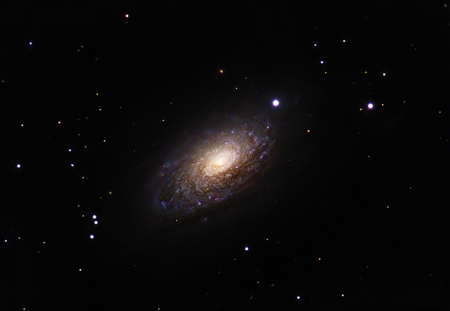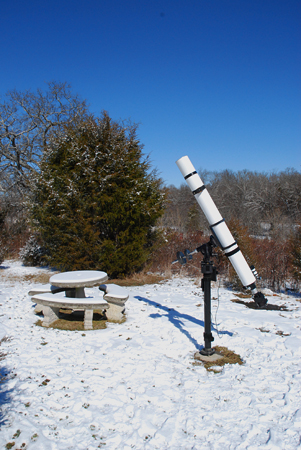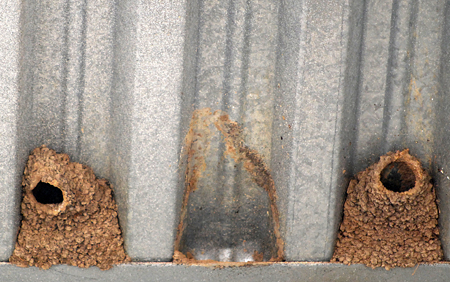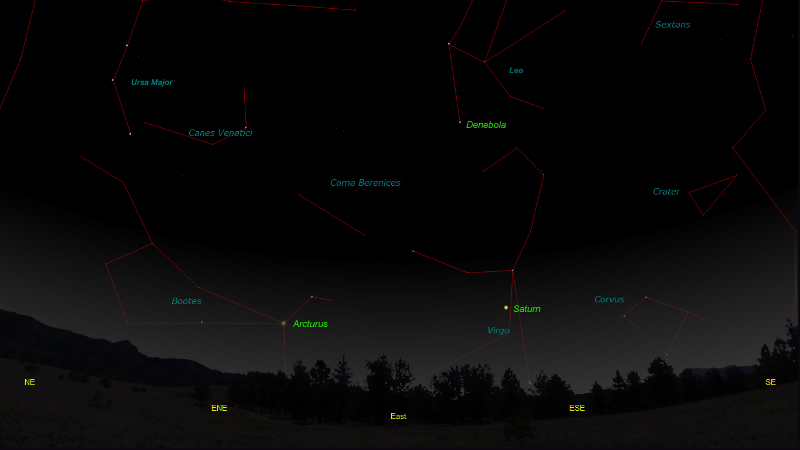The purpose of this feature is to give scout leaders, educators and naturalists an idea of some of the natural events coming up each month. We will try to cover a variety of natural events ranging from sky events to calling periods of amphibians, bird and mammal watching tips, prominent wildflowers and anything else that comes to mind. We will also note prominent constellations appearing over the eastern horizon at mid-evening each month for our area for those who would like to learn the constellations. If you have suggestions for other types of natural information you would like to see added to this calendar, let us know! Note: You can click on the hyperlinks to learn more about some of the featured items. To return to the Calendar, hit the "back" button on your browser, NOT the "back" button on the web page. All charts are available in a "printer friendly" mode, with black stars on a white background. Left clicking on each chart will take you to a printable black and white image. Please note that images on these pages are meant to be displayed at 100%. If your browser zooms into a higher magnification than that, the images may lose quality. Though we link book references to nationwide sources, we encourage you to support your local book store whenever possible. Notes and Images From February 2011 The morning of February 10th dawned clear and cold. The previous day had brought a cover of snow to our field. The coming evening was also predicted to be clear, with a low of around 7 degrees Fahrenheit. When I set up the 6" refractor that morning, the temperature was around 20 degrees. My target was to be Messier 63, a pretty open faced spiral galaxy in the constellation of Canes Venatici, the Hunting Dogs. Because the Moon would keep the sky bright early in the evening, I would not be able to begin imaging until around 10:30pm. My main concern was the laptop computer that automates the telescope and camera. It is protected from the cold only by a thin black plastic garbage bag placed over it. The bag conserves the heat produced by the computer's central processing unit, and keeps the laptop screen from being damaged by the cold.
Most nights I like to be out with the telescope during at least part of the imaging run. But on very cold nights like this, it's nice to be able to run the scope from the warmth of the house via an internet connection. On this night the scope required no help from me, and I was happy to remain warm. Messier 63 is about 37,000,000 light-years distant. It's a difficult galaxy to show well because of the brightness differences between the bright inner core of the galaxy and the outer spiral arms. The appearance gives the galaxy its nickname, "The Sunflower Galaxy." There is also a very faint halo that extends outward for some distance beyond the visible spiral arms. Many small faint background galaxies can be seen in the higher resolution image here. The galaxy was discovered on June 14th, 1779 by Pierre Mechain, and Charles Messier added it to his catalog the same day.
Vacancy: I run several times a week on a rural road near our farm. As I settle into a run I enjoy keeping track of the birds I see and hear. Last spring, for the first time, I observed Cliff Swallows building nests beneath an interstate overpass that crosses my running route. I watched as the swallows zipped in and out, building their nests, one bill-full at a time, from mud gathered from nearby Arrington Creek and the Little Harpeth River. Seventy-nine nests were soon completed, neatly fitted between the sheet metal corrugations beneath the overpass. The bridge vibrated as 18-wheelers rumbled by overhead, but the swallows didn't seem to mind. Of course, there are always those individuals who know how to manipulate the system. The following excerpt is from Arthur Cleveland Bent's Life Histories of North American Flycatchers, Larks, Swallows, and Their Allies:
Cliff Swallows are one of six species of swallows that nest in Tennessee. The upper side of their wings and their back are blue-black, and they have a short square tail and buff rump. They are masterful flyers, and feed on many species of insects. They are among our early spring migrants, arriving by late March. The old nests beneath my overpass are a little tattered by now, and lay vacant on these gray overcast winter days. I miss the dark forms of the swallows arcing beneath the overpass. Will they return to nest again? An old saying says that one swallow does not make a spring. That may be true, but one swallow certainly gives one hope. I know that the swallows follow seasonal changes as they make their way north from their South American wintering grounds. But sometimes it seems just the other away around - that they bring the green spring landscape on those elegant wings.
Sky Events for March 2011: The Vernal Equinox, marking the beginning of Spring in the Northern Hemisphere, occurs at 6:21pm CDT on the evening of March 20th. Evening Sky: Look for Jupiter about 20 degrees above the west southwest horizon at dusk at the beginning of the month. It will get lower in the west each day as the month progresses. Keep track of it, as in a couple of weeks it will guide you to Mercury, which puts in a fine evening appearance around the middle of the month. All you need is a clear western horizon. Look for Mercury to the right and below Jupiter on March 12th, 13th and 14th, and to the right and above Jupiter on March 15th and thereafter. The two planets are closest on March 15th and are only 2 degrees apart. Mercury reaches greatest elongation from the Sun on March 22nd before gradually fading from view by the end of the month. Binoculars will make it easier to spot Mercury, though it will also be visible to the naked eye as it gets darker. Begin your search about 30 minutes after sunset. Through a telescope, Mercury is about half illuminated (45%) and pretty small (about 7 seconds of an arc). It's still fun to view the elusive planet in the twilight sky, though. The NASA spacecraft Messenger has recently entered orbit around Mercury and is about ready to begin imaging the surface. Judging by the images that the spacecraft took while approaching the planet, the view should be pretty spectacular. Orbital imaging is set to begin on March 29th at 2:40am CDT. Data will from these images will begin to be transmitted back to Earth around 6 hours later. You may want to check NASA TV to see if they have coverage. Check also here for images from orbit. Saturn rises around 8:21pm CST on March 1st in Virgo. Best views through the telescope occur when it is due south in the early morning hours. Morning Sky: Venus is a brilliant point of light in the southeast predawn sky. The planet rises around 4:12am CST at the beginning of the month. Venus and the waning crescent Moon make a pretty pair as they rise together at the beginning of the month. All times noted in the Sky Events are for Franklin, Tennessee and are Central Standard Time through March 12th and then Central Daylight Time thereafter. These times should be pretty close anywhere in the mid-state area. Constellations: The views below show the sky looking east at 9:30pm CDT on March 15th. The first view shows the sky with the constellation outlines and names depicted. Star and planet names are in green. Constellation names are in blue. The second view shows the same scene without labels. The bright star Arcturus, in Bootes, the Herdsman, makes its appearance this month in the early evening sky, a sure sign that Spring is here. In the southeast, Virgo clears the horizon this month along with Corvus, the Crow. Saturn shines brightly in Virgo. The area of sky encompassing Leo, Virgo and Como Berenices marks the heart of the great Virgo cluster of galaxies.
On Learning the Constellations: We advise learning a few constellations each month, and then following them through the seasons. Once you associate a particular constellation coming over the eastern horizon at a certain time of year, you may start thinking about it like an old friend, looking forward to its arrival each season. The stars in the evening scene above, for instance, will always be in the same place relative to the horizon at the same time and date each March. Of course, the planets do move slowly through the constellations, but with practice you will learn to identify them from their appearance. In particular, learn the brightest stars (Like Arcturus and Denebola in the above scene looking east), for they will guide you to the fainter stars. Once you can locate the more prominent constellations, you can "branch out" to other constellations around them. It may take you a little while to get a sense of scale, to translate what you see on the computer screen or what you see on the page of a book to what you see in the sky. Look for patterns, like the stars of Corvus the Crow. The earth's rotation causes the constellations to appear to move across the sky just as the sun and the moon appear to do. If you go outside earlier than the time shown on the charts, the constellations will be lower to the eastern horizon. If you observe later, they will have climbed higher. As each season progresses, the earth's motion around the sun causes the constellations to appear a little farther towards the west each night for any given time of night. The westward motion of the constellations is equivalent to two hours per month. Recommended: Sky & Telescope's Pocket Star Atlas is beautiful, compact star atlas. It is destined to become a classic, and is a joy to use at the telescope. A good book to learn the constellations is Patterns in the Sky, by Hewitt-White. You may also want to check out at H. A. Rey's classic, The Stars, A New Way to See Them. For skywatching tips, an inexpensive good guide is Secrets of Stargazing, by Becky Ramotowski. A good general reference book on astronomy is the Peterson
Field Guide,
A Field Guide to the Stars and Planets, by Pasachoff. The book retails for around $14.00. Starry Night has several software programs for learning the night sky. Visit the Starry Night web site at www.starrynight.com for details.
Amphibians:
We have already heard Upland Chorus Frogs, Southern Leopard Frogs, Spring Peepers and American Toads calling this year. The warm wet weather towards the end of February has helped increase calling activity. In West Tennessee, Crawfish Frogs continue to give their loud snoring calls early in the month. At higher elevations, listen for Mountain Chorus Frogs. Towards the end of the month listen for Pickerel Frogs doing their "yeeooow" call. Remember that on mild nights you may find frogs and toads out foraging that you do not hear until later in the season. On warm days listen for early treefrogs, like Cope's Gray Treefrog, and for early Northern Cricket Frogs. The Northern Cricket Frogs at our pond often call just before a train passes by our field, possibly stimulated by the vibrations. Recommended: The Frogs and Toads of North America, Lang Elliott, Houghton Mifflin Co.
Archives (Remember to use the back button on your browser, NOT the back button on the web page!) Natural Calendar February 2011 Natural Calendar December 2010 Natural Calendar November 2010 Natural Calendar September 2010 Natural Calendar February 2010 Natural Calendar December 2009 Natural Calendar November 2009 Natural Calendar September 2009 Natural Calendar February 2009 Natural Calendar December 2008 Natural Calendar November 2008 Natural Calendar September 2008 Natural Calendar February 2008 Natural Calendar December 2007 Natural Calendar November 2007 Natural Calendar September 2007 Natural Calendar February 2007 Natural Calendar December 2006 Natural Calendar November 2006 Natural Calendar September 2006 Natural Calendar February 2006
Natural Calendar
December 2005
Natural Calendar
November 2005
Natural Calendar
September 2005
Natural Calendar
February 2005
Natural Calendar
December 2004
Natural Calendar
November 2004
Natural Calendar
September 2004
Natural Calendar
February 2004
Natural Calendar
December 2003
Natural Calendar
November 2003
Natural Calendar
September 2003 Natural Calendar February 2003 Natural Calendar December 2002 Natural Calendar November 2002 Nature Notes Archives: Nature Notes was a page we published in 2001 and 2002 containing our observations about everything from the northern lights display of November 2001 to frog and salamander egg masses. Night scenes prepared with The Sky 6 Professional from Software Bisque All images and recordings © 2011 Leaps |
|||||||





